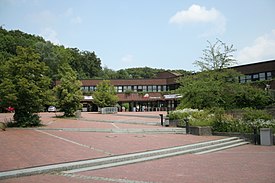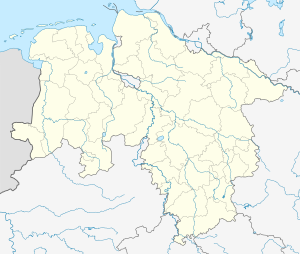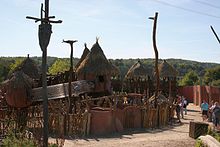Osnabrück Zoo
| Osnabrück Zoo | ||
|---|---|---|
| particularities | Underground zoo, "Takamanda", "Kajanaland" with high-altitude trails, "Angkor Wat" | |
| place | Klaus-Strick-Weg 12 49082 Osnabrück |
|
| surface | 23.5 hectares | |
| opening | 1936 | |
| Animal species | 292 animal species | |
| Individuals | 2238 animals (2019) | |
| Visitor numbers | 1,050,000 (2019) | |
| organization | ||
| management | Andreas Busemann (Commercial Director) | |
| Sponsorship | Zoo Osnabrück gGmbH | |
| Funding organizations | Zoogesellschaft Osnabrück e. V. | |
| Member of | WAZA , EAZA , VdZ | |
|
Entrance building of the Osnabrück Zoo |
||
| http://www.zoo-osnabrueck.de/ | ||
|
|
||
Coordinates: 52 ° 15 ′ 0 ″ N , 8 ° 4 ′ 13 ″ E
The Osnabrück Zoo is a zoo in the south of Osnabrück . It is located on the slopes of the Schölerberg in a beech forest and is therefore also called the forest zoo . It was founded in 1935 as a "Heimattiergarten" and opened in the summer of 1936. 2238 animals from 292 animal species can be seen on 23.5 hectares (as of 2019). In 2019, as in previous years, the zoo recorded just over a million visitors.
description
Osnabrück Zoo is located in a hilly forest area. It is divided into several themed landscapes in which animals from the same habitat live together. The museum on Schölerberg is attached to the zoo .
The zoo has placed a focus on Africa: In the two Africa areas Samburu and Takamanda , animal representatives live exclusively from this continent. Animals from Africa sometimes live in the other areas of the zoo. In addition to the Africa areas, the zoo has an aquarium, a South America area, an Asian temple landscape based on the model of Angkor Wat , the underground zoo with terrestrial inhabitants and nocturnal animals, the Nordic taiga landscape Kajanaland and the North America area Manitoba . However, there are also animal enclosures that are not assigned to any subject area. B. seals , penguins , sea lions , various bird species and a training apiary . There are also two petting zoos : the NOZ -Preichelland and a petting zoo with African animals in Takamanda.
There are three large playgrounds for children in the zoo: Makatanda with a tree house village and swings, the giraffe playground with a large slide and the NOZ children's area with a mud playground and an old steam locomotive . The gastronomy includes several food stands and kiosks as well as a zoo restaurant. There is a souvenir shop in the entrance area.
In addition to the task of introducing visitors to the biological diversity of the fauna of planet earth in an exciting way and inspiring them to preserve this diversity for future generations, the zoo is also directly involved in species conservation programs. The largest drill breeding group within the European Endangered Species Program (EEP) has been located here since 2015 .
history
Osnabrück Zoo was founded as a home zoo in July 1935 and opened on July 26, 1936.
Zoo friends had come together in the "Community of Friends of the Home Zoo". The plan to found a zoo in Osnabrück was put into practice with the help of donations. The first animals were a badger , a fox and a bear . An aviary, an owl tower, a stag and deer fence and an aquarium followed a little later. In 1938 the first bears arrived in the still small zoological garden.
In April 1945, as a result of the Second World War, the number of animals in the home zoo was very low, the zoo was badly damaged and in debt. The ambitions were nevertheless great after the war, so the “Heimattiergarten” was renamed “Tiergarten” in 1947 and the first monkeys moved in. In 1959 and 1960 a warm house, a penguin enclosure and the first elephant house were built. On April 17, 1961, the first Indian elephant Toni , bought by the circus William Althoff , moved in. A week later the cow Targa joined them. In 1968 the antelope enclosure was opened. 1970 was Tiergarten Osnabrück in Osnabrück Zoo renamed. The sea lion enclosure was built in 1973 and the South America area was opened in 1975, funded by the Wilhelm Karmann Foundation. A multi-purpose warm house opened in May 1975 burned down on the night of January 3 to 4, 1978 due to chewed electrical cables, killing dozen animals and causing property damage of around two million D-Marks.
From 1980 onwards, a number of new buildings, conversions and extensions were made with the focus on animal welfare and the aim of developing the zoo into a nature adventure park with individual themed landscapes. In 1986 the new entrance area with the administration and the attached natural history museum was opened on the Schölerberg . In 1988 and 1989 a tropical hall, the aquarium, a new penguin enclosure and an expanded outdoor enclosure for the great apes were built. The new elephant park was completed in 1998.
In 2004 the opening of the Samburu landscape took place. Giraffes live here together with zebras, ostriches and other African animals. In September 2006, Suma , a female orangutan , who over time had become a favorite of the zoo's public, died. In 2007 the elephant and rhinoceros enclosure were merged into one landscape, the valley of the gray giants . In March 2009, the Osnabrück Zoo was expanded to include a unique underground zoo . The 5.5 hectare Takamanda Africa area opened in June 2010 , for which the zoo grounds were expanded to the south ( Autobahn 30 ). The cost of this project was ten million euros. In July 2011 the new taiga landscape Kajanaland was opened. The investment costs amounted to 2.9 million euros.
For the 75th anniversary of the zoo, the Prime Minister of Lower Saxony , David McAllister , opened the exhibition of the United Buddy Bears - The Minis together with Mayor Boris Pistorius and Zoo President Reinhard Coppenrath ; an “Campaign for Peace and Tolerance”, which generated donations of 120,000 euros that benefit the zoo and children's facilities. In May 2012 a new facility for Asian pig monkeys was opened. A temple based on the model of Angkor Wat was built in the center of the zoo . The opening of the interactive climate exhibition Klimatopia with the climate ambassadors and mascots Tips and Taps , two hybrid bears born in Osnabrück Zoo , took place on April 11, 2013. The new tiger enclosure was opened in April 2014. Like the pig monkey enclosure that opened in 2012, it is designed in the style of an Asian temple complex. In September 2017, the third section of the Angkor Wat area was inaugurated with the renovation and expansion of the ape house and the enclosure of the popular orangutan "Buschi". The “Wir für Buschi” fundraising campaign alone contributed a third of the costs, amounting to 1.5 million euros.
In the northeast of the zoo, the North American landscape of Manitoba was opened in October 2018 . In September 2017, the first forest bison moved into their 3800 square meter outdoor area. By the end of 2020, the rhino and lion enclosures will be rebuilt and combined into a common themed area, Mapungubwe . Following this, the new water worlds theme area for sea lions, seals and penguins is to be built by 2022 . After that, the elephant enclosure is to be renewed, which would have renewed all of the zoo's large enclosures since 2004.
Overall, in recent years many of the old, often narrow enclosures built with lots of concrete and grids have been replaced by modern, species-appropriate and open themed landscapes that can be freely viewed by visitors.
Incident in March 2017
On March 11, 2017, around 2:15 p.m., the hybrid bear Tips broke out of the enclosure in the Kajanaland area, opened in 2011, where she had lived with her brother Taps . Visitors made the zoo staff aware of the runaway she-bear, who was moving towards the entrance to the park. The approximately 4,000 zoo visitors were warned by announcements and brought to safety in animal houses. On her foray, the bear knocked over an employee who was hardly injured. Zoo workers tried unsuccessfully to calm the animal. When the bear went on to attack the employees, she was shot. The zoo then stated that an anesthetic would only take effect after 10 to 20 minutes.
The other bear stayed in the enclosure and was locked in its stall until further notice. On the same day, the zoo was reopened to visitors, with the exception of the area around the bear enclosure.
The examination of the outbreak traces revealed that the she-bear, which had recently ended its hibernation, first overcame an electric fence when it broke out. Then she squeezed through an opening only about 40 cm in size that connects the bear enclosure with the adjoining silver fox enclosure. She then used her body weight to bend an element of the enclosure fence, which ultimately made her escape. In response to the incident, the zoo subjected its enclosures and visitor facilities to a security review.
In November 2017, the zoo decided to make the previously frozen animal body of the female bear available to the State Museum of Natural History in Stuttgart for further research into the hybrid formation between polar and brown bears .
Areas
Valley of the Gray Giants
In addition to rhinos and elephants, there are also rarely shown animals such as the sand cat , lesser kudu and the short-eared elephant living in the valley of the gray giants .
Tetra aquarium and terrarium
With the help of Tetra GmbH , an aquarium house was built in which a wide variety of aquatic animals can be accommodated. The aquarium has a freshwater and a saltwater area as well as a fish petting pool . There are also several terrariums with snakes , giant tortoises and spectacled caimans . As a special feature, you can watch leaf-cutter ants transporting cut plant leaves from their feeding place through transparent tubes into their burrow. In the terrarium there is a warm, humid rainforest climate with 70% humidity and a temperature of around 30 ° C. An artificial thunderstorm is created three times a day in the caiman facility.
South America area
In addition to the outdoor enclosures for tapirs , maned wolves and for vicunas and rheas , a South House is located here with capybaras , sloths , constrictor snakes , marmosets and the so-called "Mendoza Hall" (formerly "tropical hall"), in the flora and fauna of Northern Argentina plateau are modeled on the province of Mendoza .
Samburu (Africa)
In Samburu, giraffes , ostriches , eland antelopes , elliptical waterbuck , bush hyrax and impalas are found on around two hectares . In the safari camp you can dine and watch the animals at the same time. The facility is named after the Samburu National Reserve , a national park in northern Kenya.
Underground zoo
In an underground tunnel, visitors to the zoo can observe earth dwellers such as naked mole rats , prairie dogs or hamsters . On around 500 m², visitors have special insights into the animal structures. The construction costs of the underground zoo amounted to around 1.2 million euros. In 2017, an area originally conceived as an exhibition space was converted into a bat grotto. It houses shrew long-beaked shrews ( Glossophaga soricina ), also known as the common blossom bat, from the leaf-nose family .
Takamanda (Africa)
The African landscape "Takamanda" is home to golden jackals , greater kudu , house donkeys , coat baboons , brush-eared pigs , sable antelopes , chimpanzees , servals , spotted hyenas , warthogs , the very rare and endangered white-headed mongoose and zebra mongoose . A total of 80 animals live on the 5.5 hectare area, which is modeled on a savannah landscape and named after a national park in Cameroon . There is also a tree house village "Makatanda" with a playground and petting zoo in this themed landscape.
Kajanaland (Northern Europe)
Kajanaland is modeled on the northern European taiga landscape . Here live bison , lynx , wolverines , raccoons , reindeer , arctic foxes , silver foxes and bears . Some of the enclosures can be viewed from above via a tree-height path from a height of up to six meters. This guided tour is so far unique in German zoos.
A replica of a megalithic grave has been located on the western edge of the zoo since the 1980s . For the replica, stones from one of the large stone graves near Nahne were moved to the zoo. Since 2011, when the area was redesigned to today's Kajanaland and the route was changed, the grave is no longer directly accessible to visitors.
Angkor Wat (Asia)
The Asian temple landscape, modeled on Angkor Wat , consists of a walk-in " monkey temple" with southern pig monkeys , a tiger enclosure and an ape house . The painting orangutan "Buschi", a public favorite of the zoo , also lives here . The income from the sold works goes into the tapir protection project "Tajya-Saruta", which the Osnabrück Zoo has been supporting since 2003.
Manitoba (North America)
The 3.5 hectare area, named after the Canadian province of Manitoba , opened on October 5, 2018. The renovation work for the North American landscape amounted to a total of 3.5 million euros. The first forest bison (Bison Bison Athabascae) , Hudson Bay wolves (Canis lupus hudsonicus) and black bears (Ursus americanus) moved into the first section in 2017 . In the meantime, various small mammals such as tree porcupines , marmots and skunks , but also bearded owls and snowy owls populate the area. A beaver castle gives an insight into the life of the Canadian beaver .
reviews
In the rankings of European zoos by the British zoo expert Anthony Sheridan, Osnabrück Zoo reached the top places in the group several times with 500,000 to 1 million visitors annually. The zoo was in second place in the 2011 and 2013 rankings, and in 2015 it was tied for third place with the Münster Allwetterzoo .
In a customer survey conducted by Service Value GmbH in 2012, in which visitors from 20 German zoos were asked about the service they experienced, Osnabrück Zoo took first place.
literature
- Herbert Sprado: Osnabrück Zoo Review , Verlag Theodor Thoben, Quakenbrück 1990, ISBN 3-921176-66-2 .
- Osnabrück Zoo (Ed.): 75 Years Osnabrück Zoo - The 2011 birthday magazine, Meinders & Elstermann Verlag, Belm 2011
Web links
Individual evidence
- ↑ Inventory 2019, zoo-osnabrueck.de, January 9, 2020
- ↑ http://www.nwzonline.de/Region/Artikel/2362742/Osnabr%EF%BF%BDck++Wulff+er%EF%BF%BDffnet+Afrikalandschaft.html (link not available)
- ↑ Zoo Osnabrück (Ed.): 75 Years Zoo Osnabrück - The Birthday Magazine 2011 , Verlag Meinders & Elstermann, Belm 2011, p. 6 ff.
- ↑ Zoo Osnabrück (Ed.): 75 Years Zoo Osnabrück - The Birthday Magazine 2011 , Verlag Meinders & Elstermann, Belm 2011, p. 8 ff.
- ↑ In the 1970s a fire disaster struck the Osnabrück Zoo , noz.de, January 6, 2020.
- ↑ Osnabrück Zoo opens Nordic animal landscape , in Neue OZ , July 7, 2011
- ↑ Neue Osnabrücker Zeitung, August 18, 2011
- ↑ Neue Osnabrücker Zeitung, April 11, 2013
- ^ NOZ.de , accessed on June 27, 2013
- ↑ Sebastian Stricker: "Jungle Palace" for orangutans: Osnabrück Zoo opens new ape house. In: noz.de. September 23, 2017. Retrieved September 24, 2017 .
- ↑ "Manitoba" is now partially accessible: bison conquer the North American world in Osnabrück Zoo. In: noz.de. September 20, 2017. Retrieved September 24, 2017 .
- ↑ Mapungubwe (under construction) , zoo-osnabrueck.de, accessed on July 18, 2020.
- ↑ Minister Althusmann brings 2 million euros in funding to the zoo , zoo-osnabrueck.de, July 17, 2020, accessed on July 18, 2020.
- ↑ Double elephant offspring expected , zoo-osnabrueck.de, July 16, 2020, accessed on July 18, 2020.
- ↑ Update: Osnabrück Zoo mourns the hybrid bear "Tips" , zoo-osnabrueck.de, March 12, 2017
- ↑ New details on the death of "Tips": Bear apparently attacked Zoomitarbeiter, noz.de, March 12, 2017
- ↑ Osnabrück Zoo in mourning: Everything about hybrid bear "Tips" , hasepost.de, March 13, 2017
- ↑ After the bear outbreak: Are the other enclosures in Osnabrück Zoo nailed down? , noz.de, March 13, 2017
- ↑ Hybridbärin Tips is made available to science , Hasepost.de, November 28, 2017
- ↑ Mendoza-Halle opens at the weekend (zoo-osnabrueck.de, March 22, 2013, accessed on June 30, 2016.)
- ↑ Here you can watch naked mole rats up close. Die Welt , March 25, 2009.
- ↑ "Manitoba" is now partially accessible: bison conquer the North American world in Osnabrück Zoo. In: noz.de. September 20, 2017. Retrieved September 24, 2017 .
- ↑ Anthony Sheridan: Europe's leading zoological gardens (PDF), zoofoerderer.de, 2011, accessed on June 26, 2019
- ↑ Zoo Osnabrück second best zoo in Europe , noz.de, December 1, 2013, accessed June 26 of 2019.
- ↑ Osnabrück Zoo is one of the three best in Europe , noz.de, November 23, 2016, accessed on June 26, 2019.
- ↑ Customer survey by Service Value GmbH ( Memento from February 4, 2013 in the Internet Archive )









